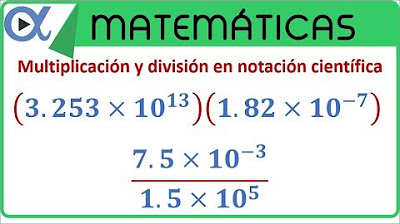Suma y resta en notación científica
Summary
TLDRThis tutorial explains how to add and subtract numbers in scientific notation. It covers how to handle numbers with the same power of 10, as well as those with different powers. When the powers match, the coefficients are simply added or subtracted while keeping the same power. When the powers differ, the numbers are adjusted to the larger power by modifying the coefficients. Examples show how to perform operations such as 4.3 * 10^13 + 2.1 * 10^13 and more complex operations with different exponents. The video aims to simplify these calculations, making scientific notation more accessible.
Takeaways
- 😀 Notation scientific numbers consist of a coefficient (a decimal number) and a power of 10.
- 😀 The coefficient in scientific notation must have one non-zero digit before the decimal point.
- 😀 The exponent of 10 gives us an idea of how large or small the number is.
- 😀 A positive exponent represents a large number, while a negative exponent represents a very small number close to zero.
- 😀 Scientific notation simplifies writing large and small numbers with fewer digits.
- 😀 When adding or subtracting numbers with the same power of 10, just add or subtract the coefficients and keep the same exponent.
- 😀 For example, adding 4.3 * 10^13 and 2.1 * 10^13 results in 6.4 * 10^13.
- 😀 When the exponents are different, choose the largest exponent and rewrite both numbers with the same power of 10 before performing the operation.
- 😀 If the exponent of 10 is increased, adjust the coefficient by multiplying or dividing by powers of 10 accordingly.
- 😀 In cases where the power of 10 needs to be adjusted, move the decimal point of the coefficient to match the desired exponent.
- 😀 The final result of operations with scientific notation will maintain the common power of 10, and the coefficients are added or subtracted as needed.
Q & A
What is scientific notation?
-Scientific notation is a way of writing numbers as a product of two factors: a coefficient and a power of 10. The coefficient is typically a decimal number, and the power of 10 represents how large or small the number is.
What is the rule for the coefficient in scientific notation?
-The coefficient in scientific notation must have only one digit before the decimal point, and that digit cannot be zero.
How does the exponent of the power of 10 affect the size of the number?
-If the exponent is positive and large, the number is very large. If the exponent is negative, the number is very small, close to zero.
Why is scientific notation used?
-Scientific notation is used to express very large or very small numbers in a more concise and manageable form.
How do you add or subtract numbers in scientific notation when the exponents are the same?
-When the exponents are the same, you add or subtract the coefficients and keep the same power of 10. For example, 4.3 * 10^13 + 2.1 * 10^13 = 6.4 * 10^13.
What do you do when the exponents are different when adding or subtracting scientific notation?
-When the exponents are different, you choose the larger exponent and rewrite both numbers with that exponent. Then, adjust the coefficients accordingly and perform the addition or subtraction.
How do you adjust the coefficients when the exponents are different?
-To adjust the coefficients, multiply or divide the coefficient by the appropriate power of 10 to match the chosen exponent.
What happens if you have to add 4.3 * 10^13 and 2.1 * 10^15?
-Since the exponents are different, you choose the larger exponent (10^15), rewrite both numbers with that exponent, and adjust the coefficients. The result will be 2.143 * 10^15.
How do you handle subtraction when the exponents differ?
-When subtracting with different exponents, you choose the larger exponent, rewrite both numbers with that exponent, and adjust the coefficients. Then, subtract the coefficients as usual.
In the example 3 * 10^-2 - 5.3 * 10^-3, how do you proceed?
-Since the exponents are different, you choose the larger exponent (10^-2). Then, adjust the coefficients accordingly, with the second coefficient being divided by 10, and subtract the coefficients. The result is 2.47 * 10^-2.
Outlines

هذا القسم متوفر فقط للمشتركين. يرجى الترقية للوصول إلى هذه الميزة.
قم بالترقية الآنMindmap

هذا القسم متوفر فقط للمشتركين. يرجى الترقية للوصول إلى هذه الميزة.
قم بالترقية الآنKeywords

هذا القسم متوفر فقط للمشتركين. يرجى الترقية للوصول إلى هذه الميزة.
قم بالترقية الآنHighlights

هذا القسم متوفر فقط للمشتركين. يرجى الترقية للوصول إلى هذه الميزة.
قم بالترقية الآنTranscripts

هذا القسم متوفر فقط للمشتركين. يرجى الترقية للوصول إلى هذه الميزة.
قم بالترقية الآنتصفح المزيد من مقاطع الفيديو ذات الصلة
5.0 / 5 (0 votes)






